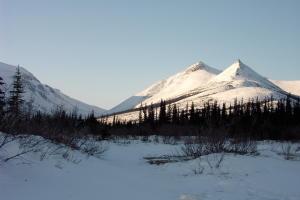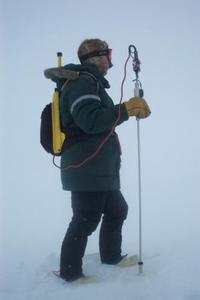9 April, 2002
Strap on a backpack, strap on the snowshoes, pull
on the mittens and head for a walk. A walk out
on the open tundra or through a snow covered
forest or perhaps across a frozen lake. This
walk needs to take the path of a straight line
across the snow. A straight line where the
wilderness has no boundaries and knows no
restrictions.
The backpack does not contain food or water. It
contains a GPS system and a data recorder for the
MagnaProbe. The GPS is a global positioning
system that operates by satellites orbiting the
Earth. GPS systems come in all shapes and sizes.
The GPS's that we are using to navigate our trip
fit in the palm of a hand. However, this GPS is
much larger and requires the backpack. It is a
more precise GPS and can have provide distance coordinates as
accurate as a meter. The GPS unit
has an antenna that sticks outside of the
backpack. This antenna receives signals
from the satellite to the GPS system.
The MagnaProbe is an instrument designed and
made by, SnowSTAR's very own, Jon Holmgren. The
MagnaProbe is a very handy way of measuring and
recording snow depth. It consists of a rod that
is approximately 1.5 meters in length. At the
end of the probe is a white basket that will ride on
the top of the snowpack. At the top of the probe
is a white control button. This button is pushed
to record the snow-depth measurement. All of the snow
depths are recorded in the data box that is
strapped to the waist belt of the backpack.
Without the MagnaProbe, depth measurements would
be much more difficult. A person would have to
write down all of the depth numbers. Writing
with mittens on is a very difficult task to do!!!
Jon's MagnaProbes are an ingenius invention! I
have been thankful many times!
Beep, beeep, beeep…. One, two, three, four, five,
six, seven and eight… BEEP, beeep, beeep. Walk
again… These are the sounds of the MagnaProbe
and GPS working together. Jon has wired them so
the both measurements can be recorded at the same
time. On a typical long walk, 200+ measurements
are recorded over a mile in distance. The
invention of the MagnaProbe has allowed us to
record and store more measurements in a given
day. The more data collected during a science
expedition allows for better analysis and
results.
WHERE IS MRS. CHEUVRONT?? LET'S PLOT!!
Latitude:67.63113 degrees North
Longitude: 157.37863 degrees West
Howling winds, frozen rivers, wind-sculpted snow, avalanche slides, deep
valleys, and massive, snow-covered rock-topped mountains. Entrance into
the Brooks Range mountains.... A mystical, enchanting, daunting place.
Ivishak pass was the name of our doorway through the beginning of the
Brooks Range. The mountains lay steeply on both sides of us, hovering
above, allowing the winds to flow heavily through the pass. The winds at
times reached 40-50 mph. The snowmachines bumped heavily along the hard,
wind-scoured snow. Footprints of wolves, foxes, and grizzlies were the
only signs of noticeable life. The wind and the cold reminded us how
remote and wild these mountains are. We stopped at the top of a peak to
perform a remote Class 2 chemical sampling. The wind cut through the thin
latex gloves. As a team working together we accomplished the task. The
safest and best way to travel was hard to determine at times. Matthew and
Eric would lead the way using the maps and GPS. Scouting the best route
proved to be troublesome with our snowmachines frequently getting stuck in
the deep snow. Tonight we camp in the heart of the Brooks Range. The
mountains have brought us deep snow on the ground and light snow in the
air. The wind is calm in our camp. Tomorrow, we travel deeper into the
mountains.
Temperature Min: -18 degrees Celsius High winds today.
Temperature Max: -12 degrees Celsius
Matthew Sturm
USA-CRREL-Alaska
P.O. Box 35170
Ft. Wainwright, AK 99703
907-353-5183
msturm@crrel.usace.army.mil

Traveling through the mountains. Eric, April, Matthew and Ken.

The Entrance of the Brooks Range Mountains

Ken with the MagnaProbe/GPS unit. The yellow backpack holds the GPS unit. The MagnaProbe has the metal rod with the basket that measures the snow depth.
Contact the TEA in the field at
.
If you cannot connect through your browser, copy the
TEA's e-mail address in the "To:" line of
your favorite e-mail package.
|
